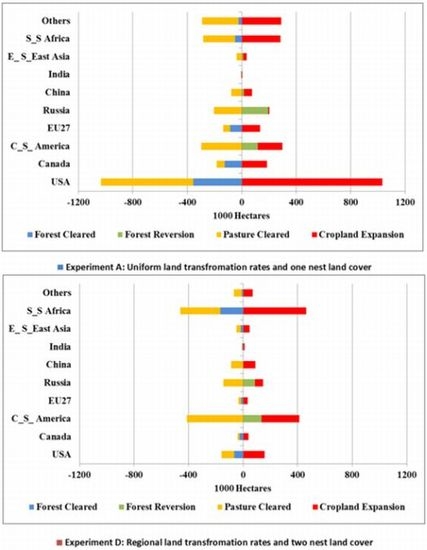Biofuels and Land Use Change: Applying Recent Evidence to Model Estimates
Abstract
:1. Introduction
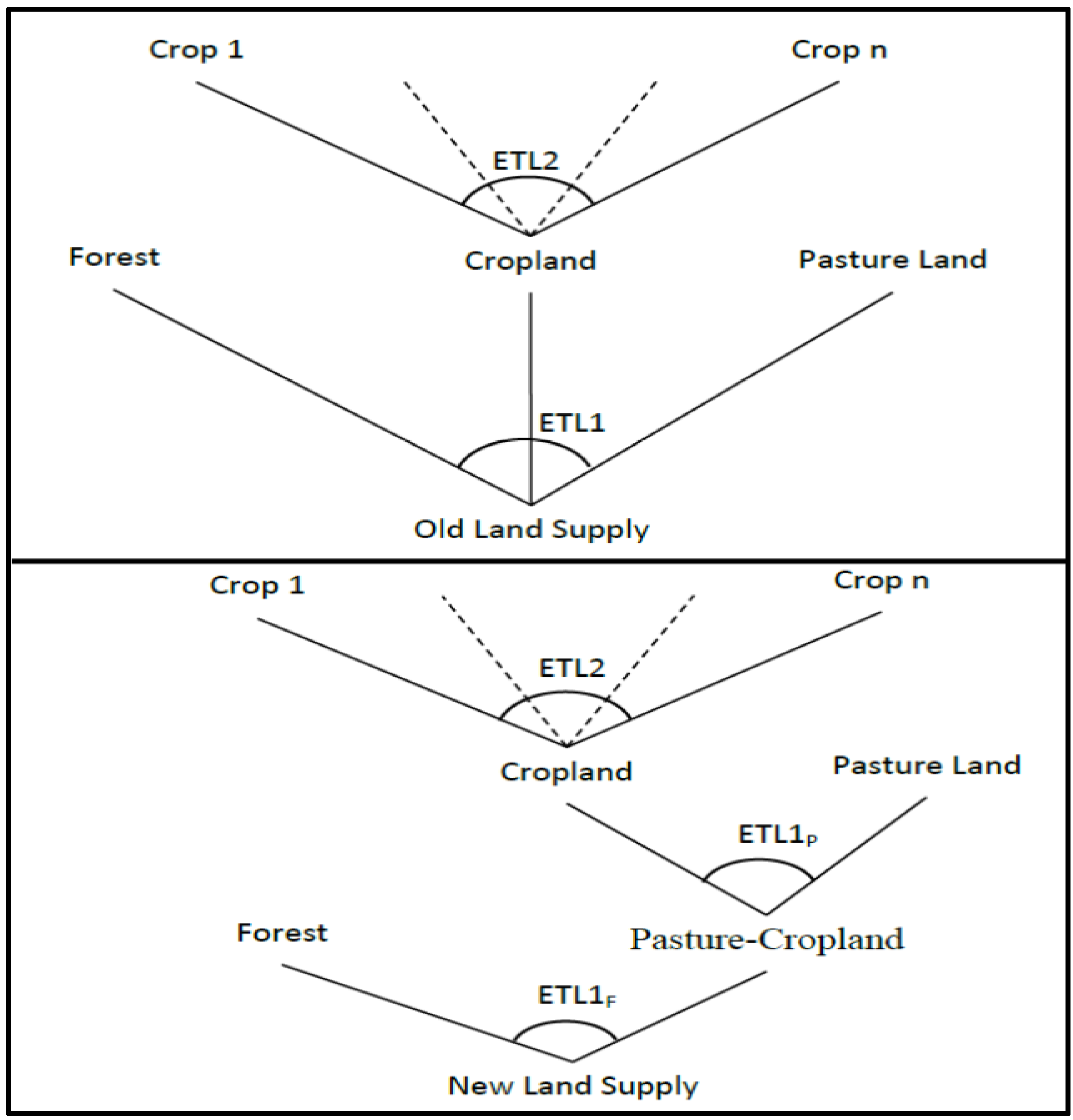
2. Experimental Section
2.1. Evolution in Agricultural Land Use and Major Land Allocation Patterns in 1990–2010
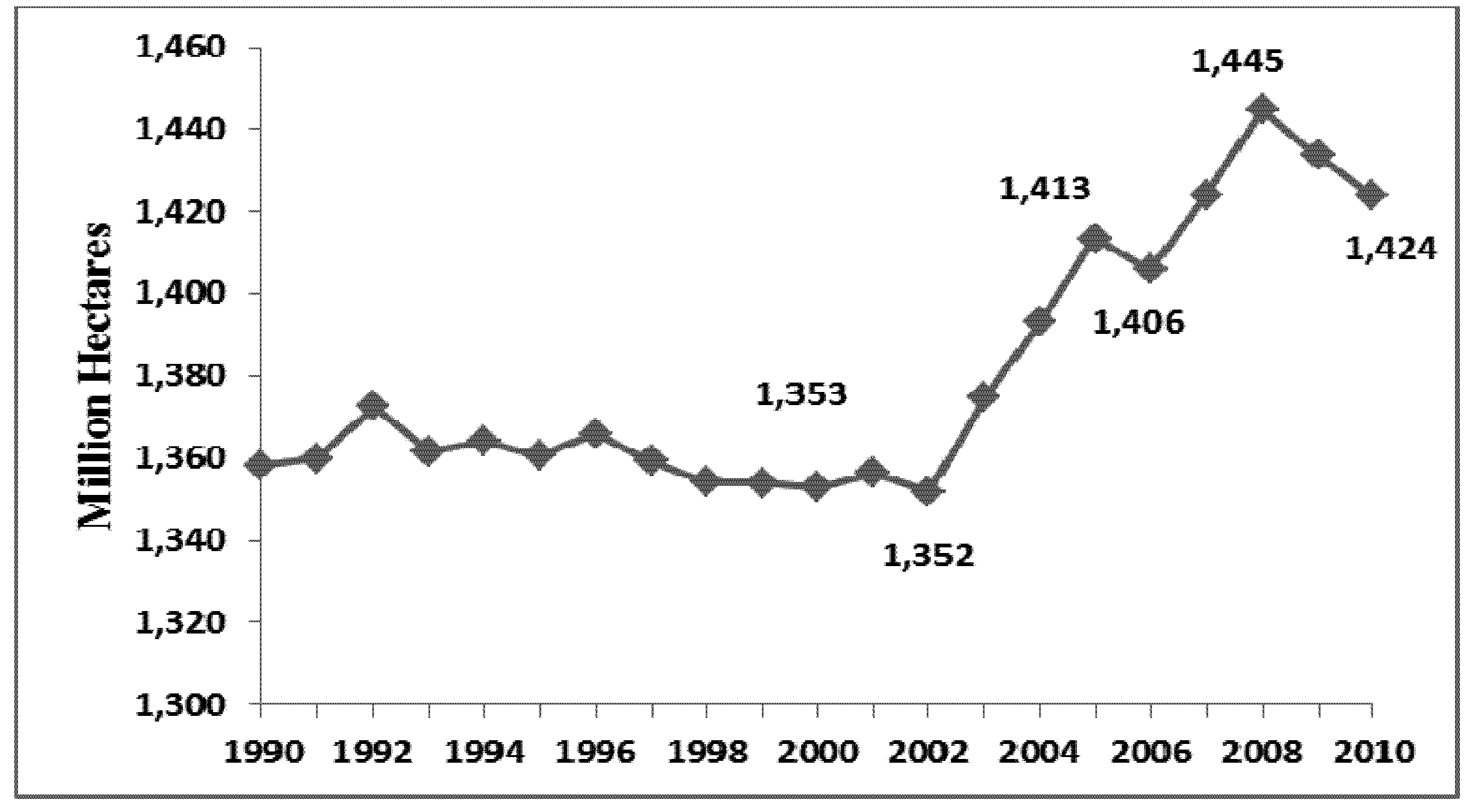
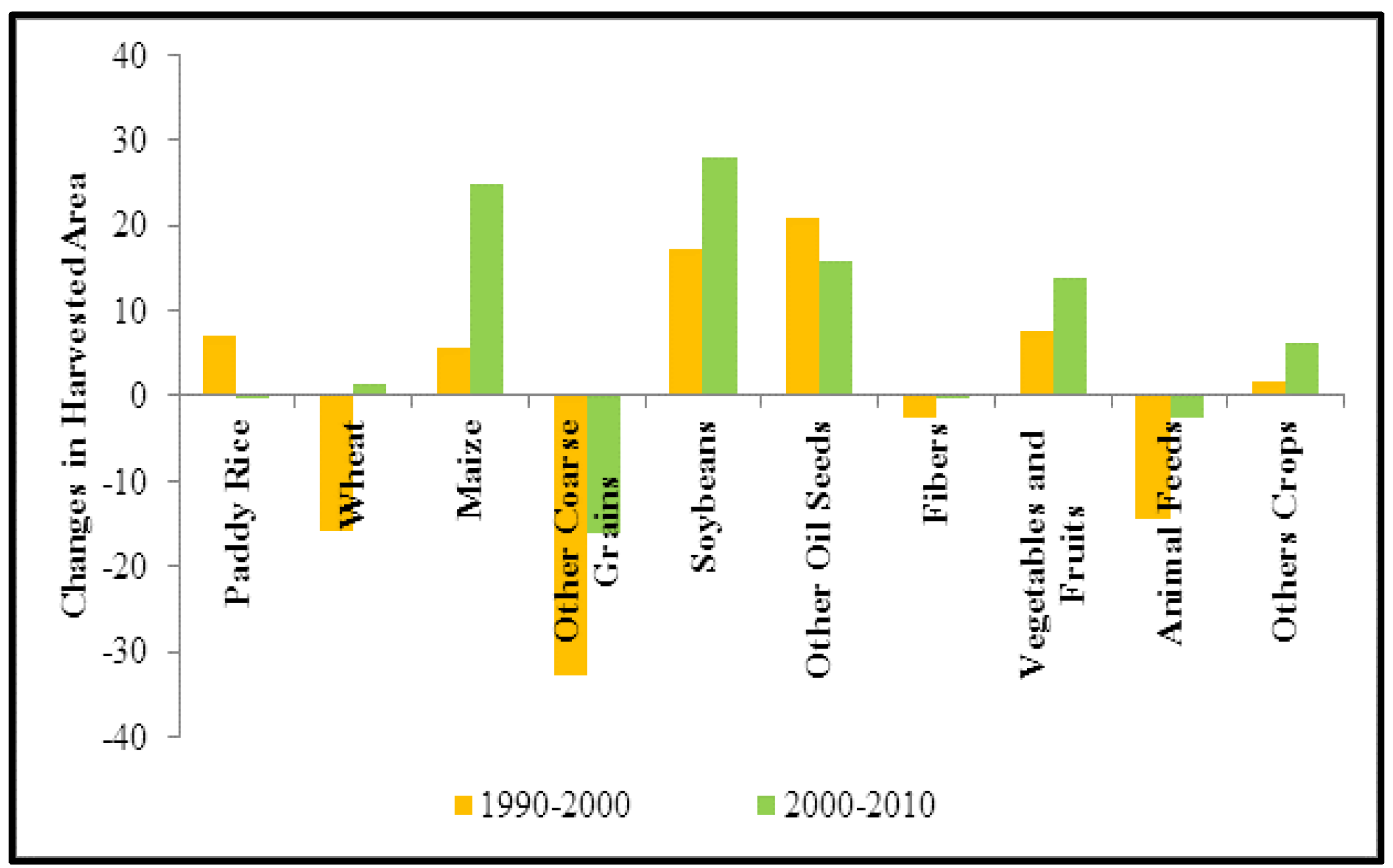
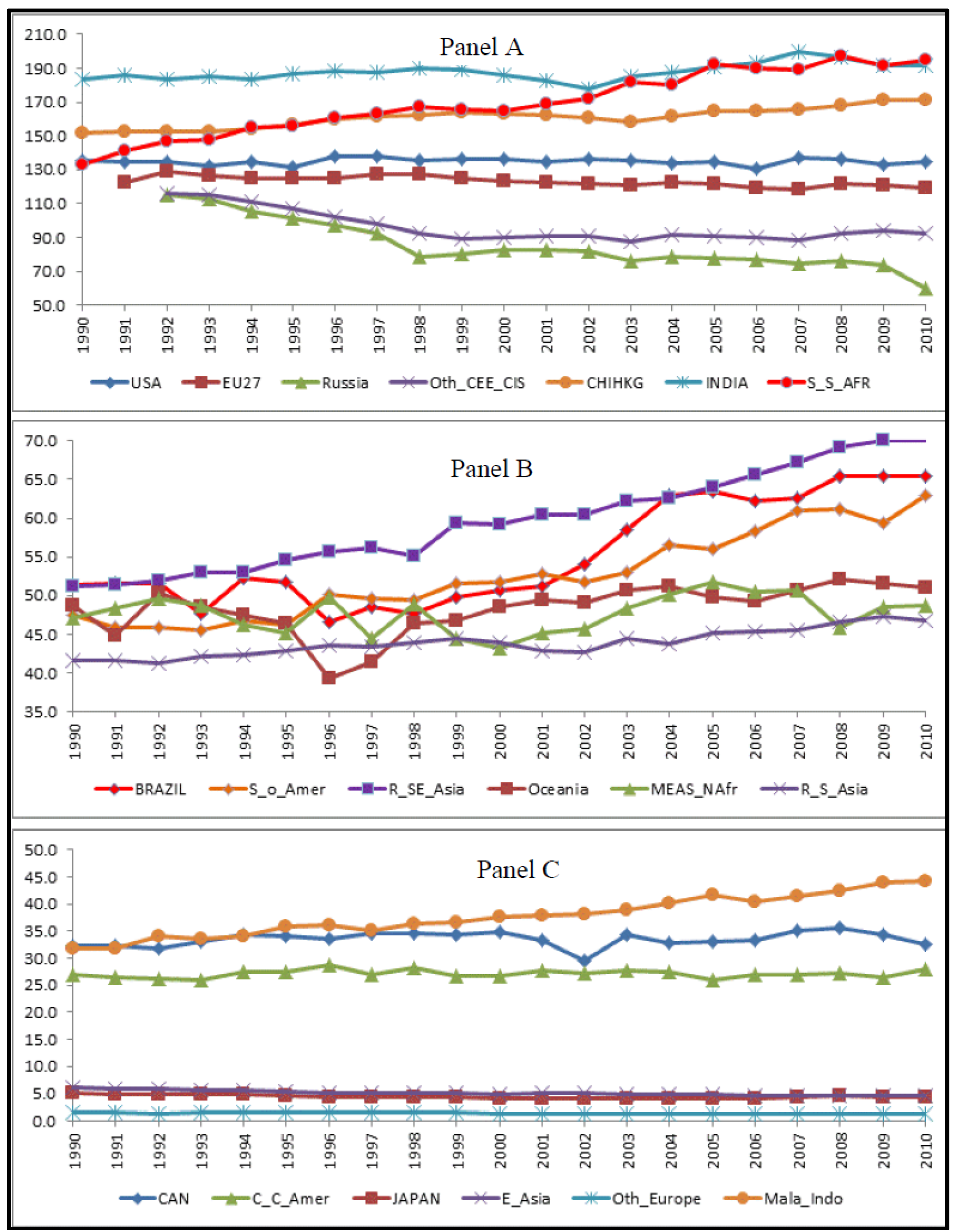
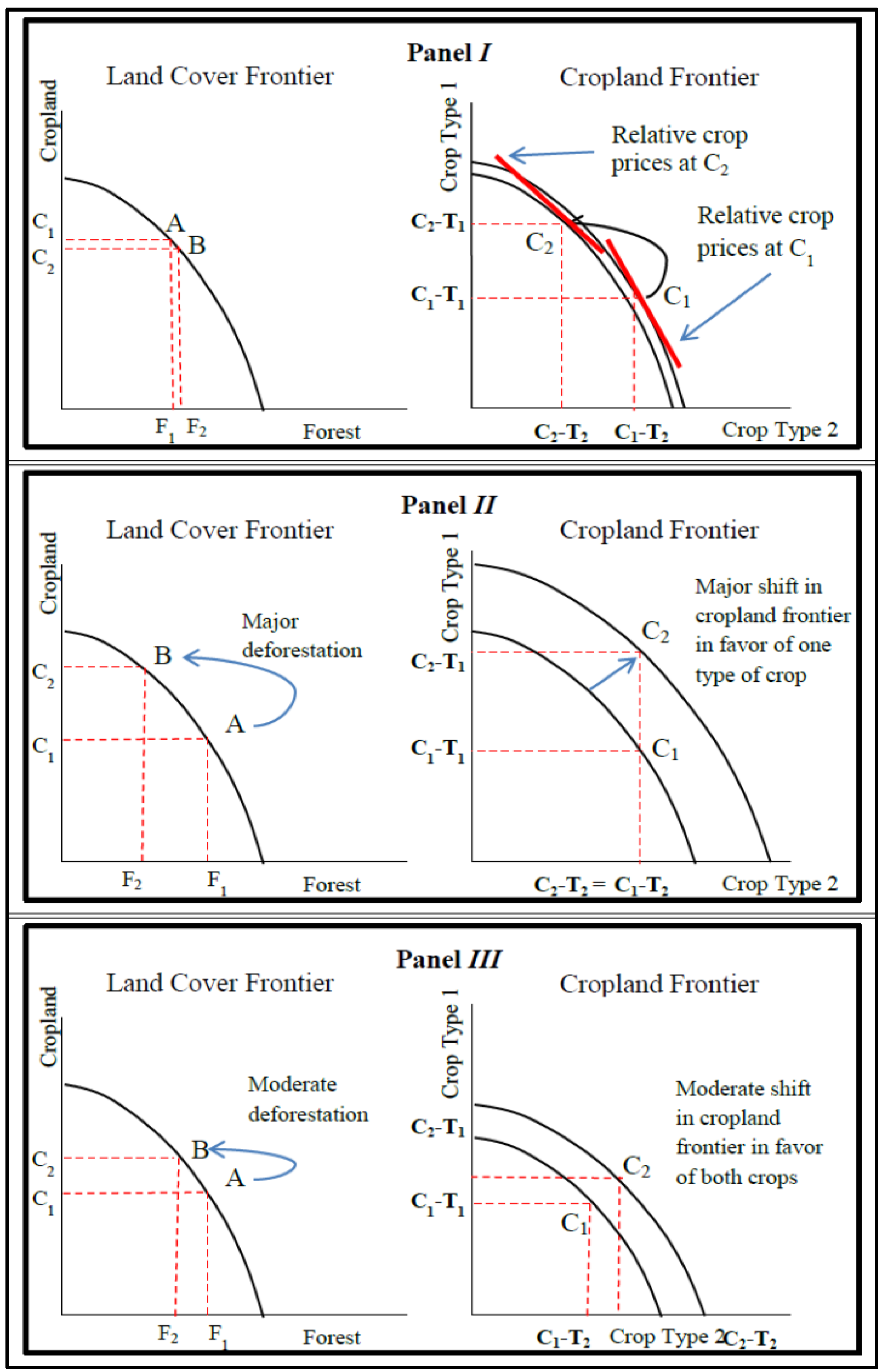
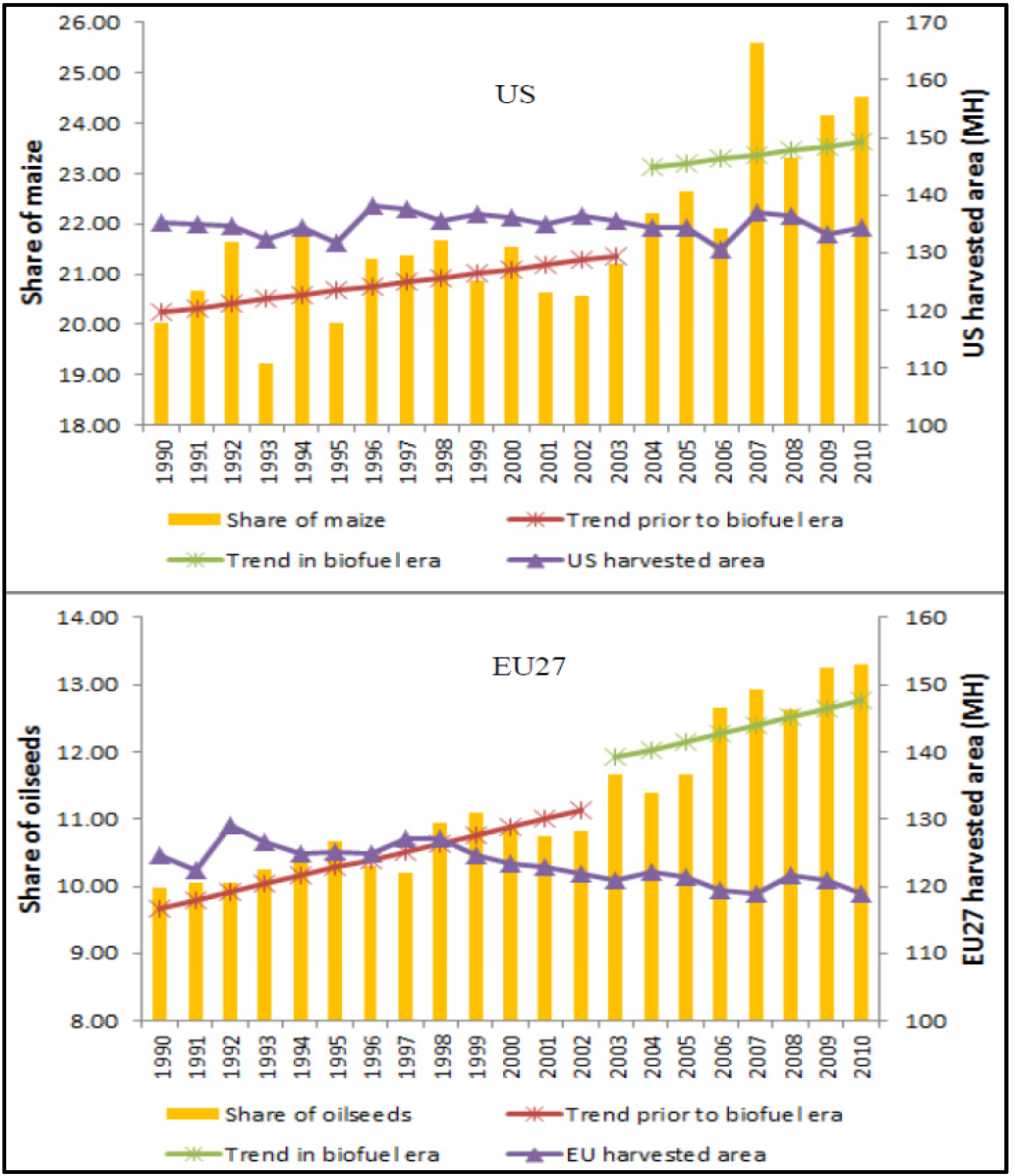
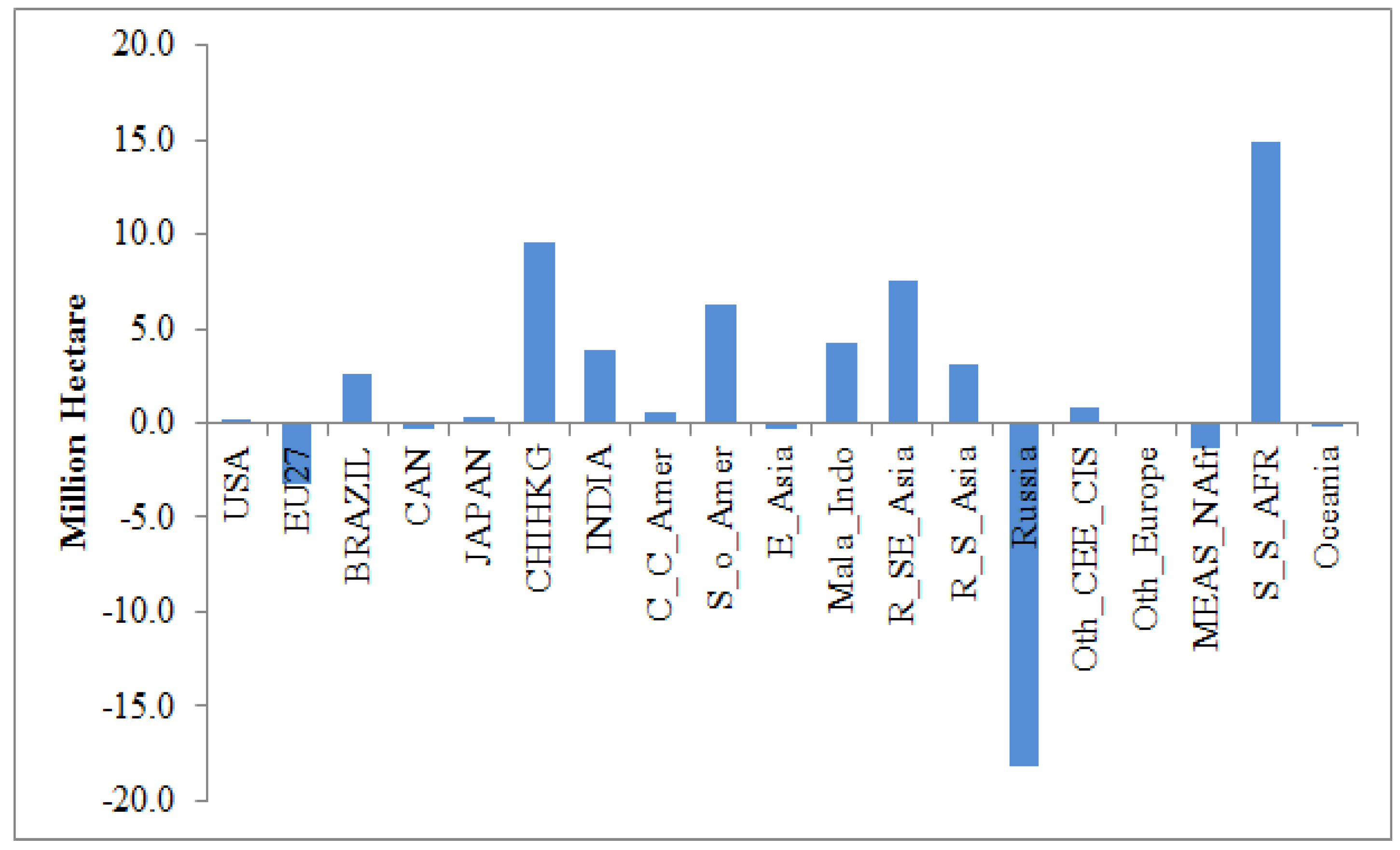
2.2. Modifications in GTAP Land Transformation Elasticities
- Regions with very low rate of land transformation: This category represents regions with very limited changes in land cover during the time period of 2004–2010. The absolute values of changes in the harvested areas of these regions were below 0.25% per year after 2004. To limit land conversion among forest, pasture, and cropland in these regions we assigned a value of ETL1=−0.02 to the lower level of the land supply nest.
- Regions with low rate of land transformation: This category represents regions with relatively low annual rates of land transformation during the targeted time period. The absolute value of changes in the harvested areas of these region where higher than 0.25% and lower than 0.75% since 2004. For these regions we assigned a value of ETL1=−0.1 (half of the original value of GTAP-BIO model) to the lower level of their land supply nest.
- Regions with high rate of land transformation: This group represents regions with relatively large changes in their harvested areas. The absolute values of changes in the harvested areas of these regions were larger than 0.75% and less than 1.5% per year since 2004. To facilitate land conversion among forest, pasture, and cropland in these regions we assigned a value of ETL1=−0.2 (the original value of GTAP-BIO model) to the lower level of the land supply nest.
- Regions with very high rate of land transformation: The last category includes regions with high very high rates of land transformation. The absolute values of changes in the harvested areas of these regions were larger than 1.5% per year during the targeted time period. A relatively high value of ETL1=−0.3 is assigned to the lower level of land supply tree of these regions.
| Regions | Absolute value of annual changes in harvested area (%) | Rank in land cover change | Tuned ETL1 | Tuned ETL2 |
|---|---|---|---|---|
| Oth_Europe | 0.06 | Very Low | −0.02 | −0.25 |
| Oceania | 0.09 | −0.02 | −0.25 | |
| CAN | 0.10 | −0.02 | −0.25 | |
| USA | 0.10 | −0.02 | −0.75 | |
| MEAS_NAfr | 0.11 | −0.02 | −0.25 | |
| Oth_CEE_CIS | 0.14 | −0.02 | −0.75 | |
| C_C_Amer | 0.17 | −0.02 | −0.25 | |
| EU27 | 0.22 | −0.02 | −0.75 | |
| INDIA | 0.49 | Low | −0.1 | −0.25 |
| R_S_Asia | 0.73 | −0.1 | −0.25 | |
| Russia | 1.00 | High | −0.2 | −0.75 |
| JAPAN | 1.09 | −0.2 | −0.5 | |
| CHIHKG | 1.10 | −0.2 | −0.25 | |
| E_Asia | 1.11 | −0.2 | −0.5 | |
| BRAZIL | 1.54 | Very High | −0.3 | −0.5 |
| R_SE_Asia | 1.68 | −0.3 | −0.5 | |
| Mala_Indo | 1.82 | −0.3 | −0.25 | |
| S_o_Amer | 2.37 | −0.3 | −0.25 | |
| S_S_AFR | 2.50 | −0.3 | −0.5 |
 . For example, suppose point A represents the year 2003 (one year before biofuel boom) and point B represents 2010. Then ATE = −0.86 for the USA economy between 2003 and 2010. If we change the base to 2002 then ATE = −0.76 and if we change the end year to 2009 then ATE = −0.67. Note that in calculating these values we dropped the term
. For example, suppose point A represents the year 2003 (one year before biofuel boom) and point B represents 2010. Then ATE = −0.86 for the USA economy between 2003 and 2010. If we change the base to 2002 then ATE = −0.76 and if we change the end year to 2009 then ATE = −0.67. Note that in calculating these values we dropped the term  from the above formula because XB were equal YB in recent years. All of these numbers are indeed around ETL2 = −0.75 used in the latest versions of GTAP-BIO developed by Taheripour et al. [17] and Tyner et al. [18]. We considered this value of ETL2 as the highest rate of land transformation for the cropland cover. The cropland transformation elasticities of other regions are tuned with respect to this benchmark. To accomplish this task the same high value of −0.75 is assigned to the ETL2 for EU, Russia, and Oth_CEE_CIS regions, which observed limited or no expansion in their cropland and moved their existing cropland to MO crops since 2004. On the other hand, for those regions which experienced no major expansion in their cropland area and had no significant changes in their land allocation among crops, we assigned a low value of −0.25 to their ETL2 rate. Several regions including Canada, C_C_Amer, Oth_Europe, MEAS_NAfr, and Oceania fall in this group.
from the above formula because XB were equal YB in recent years. All of these numbers are indeed around ETL2 = −0.75 used in the latest versions of GTAP-BIO developed by Taheripour et al. [17] and Tyner et al. [18]. We considered this value of ETL2 as the highest rate of land transformation for the cropland cover. The cropland transformation elasticities of other regions are tuned with respect to this benchmark. To accomplish this task the same high value of −0.75 is assigned to the ETL2 for EU, Russia, and Oth_CEE_CIS regions, which observed limited or no expansion in their cropland and moved their existing cropland to MO crops since 2004. On the other hand, for those regions which experienced no major expansion in their cropland area and had no significant changes in their land allocation among crops, we assigned a low value of −0.25 to their ETL2 rate. Several regions including Canada, C_C_Amer, Oth_Europe, MEAS_NAfr, and Oceania fall in this group.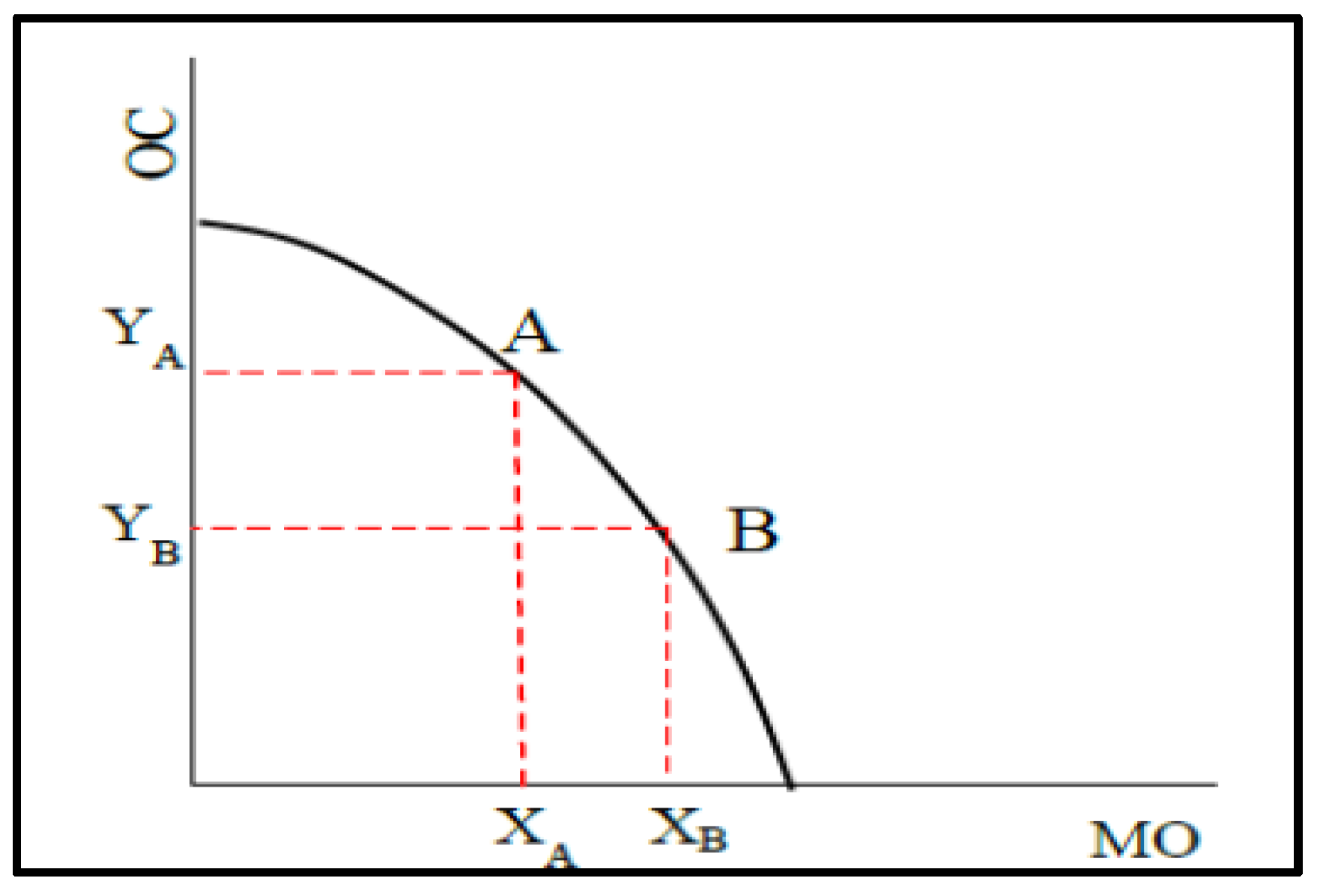
2.3. Change in the Land Cover Nesting Structure
| Regions | Rank in land cover change | Tuned ETL1 | Tuned ETL1F | Tuned ETL1P | Tuned ETL2 |
|---|---|---|---|---|---|
| Oth_Europe | Very Low | −0.02 | −0.018 | −0.0218 | −0.25 |
| Oceania | −0.02 | −0.018 | −0.0218 | −0.25 | |
| CAN | −0.02 | −0.018 | −0.0218 | −0.25 | |
| USA | −0.02 | −0.018 | −0.0218 | −0.75 | |
| MEAS_NAfr | −0.02 | −0.018 | −0.0218 | −0.25 | |
| Oth_CEE_CIS | −0.02 | −0.018 | −0.0218 | −0.75 | |
| C_C_Amer | −0.02 | −0.018 | −0.0218 | −0.25 | |
| EU27 | −0.02 | −0.018 | −0.0218 | −0.75 | |
| INDIA | Low | −0.1 | −0.0909 | −0.1091 | −0.25 |
| R_S_Asia | −0.1 | −0.0909 | −0.1091 | −0.25 | |
| Russia | High | −0.2 | −0.1818 | −0.2182 | −0.75 |
| JAPAN | −0.2 | −0.1818 | −0.2182 | −0.5 | |
| CHIHKG | −0.2 | −0.1818 | −0.2182 | −0.25 | |
| E_Asia | −0.2 | −0.1818 | −0.2182 | −0.5 | |
| BRAZIL | Very High | −0.3 | −0.2727 | −0.3273 | −0.5 |
| R_SE_Asia | −0.3 | −0.2727 | −0.3273 | −0.5 | |
| Mala_Indo | −0.3 | −0.2727 | −0.3273 | −0.25 | |
| S_o_Amer | −0.3 | −0.2727 | −0.3273 | −0.25 | |
| S_S_AFR | −0.3 | −0.2727 | −0.3273 | −0.5 |
3. Results and Discussion
3.1. Land Use Impacts of USA Ethanol Mandate
- Experiment A. An increase in corn ethanol production from its 2004 level (3.41 billion gallons [BG]) to 15 BG, using a land supply tree including a one-nest land cover structure with uniform land transformation rates of ETL1=−0.2 and ETL2=−0.75 across the world.
- Experiment B. An increase in corn ethanol production from its 2004 level (3.41 billion gallons [BG]) to 15 BG, using a land supply tree including a one-nest land cover structure with regional land transformation rates presented in Table 1.
- Experiment C. An increase in corn ethanol production from its 2004 level (3.41 billion gallons [BG]) to 15 BG, using a land supply tree including a two-nest land cover structure with uniform land transformation rates of ETL1 = −0.2 and ETL2 = −0.75 across the world while we assume in each region ETL1P is 20% larger than ETL1F.
- Experiment D. An increase in corn ethanol production from its 2004 level (3.41 billion gallons [BG]) to 15 BG, using a land supply tree including a two-nest land cover structure with regional land transformation rates presented in Table 2.
| Regions | Experiment A: Uniform land transformation rates of ETL1 = −0.2 and ETL2 = −0.75 | Experiment B: Regional land transformation rates Presented in Table 1 | ||||
|---|---|---|---|---|---|---|
| Forest | Cropland | Pasture | Forest | Cropland | Pasture | |
| USA | −357.4 | 1033.3 | −675.8 | −91.6 | 155.7 | −64.1 |
| EU27 | −85.8 | 136.2 | −50.4 | −21.2 | 33.6 | −12.5 |
| BRAZIL | −3.6 | 91.6 | −88.0 | 21.7 | 152.1 | −173.8 |
| CAN | −123.9 | 184.5 | −60.6 | −29.4 | 41.0 | −11.7 |
| JAPAN | −3.0 | 3.5 | −0.5 | −5.3 | 5.3 | 0.0 |
| CHIHKG | 17.1 | 59.4 | −76.4 | −13.2 | 89.7 | −76.5 |
| INDIA | −2.2 | 5.2 | −3.0 | −7.4 | 10.7 | −3.3 |
| C_C_Amer | 34.8 | 22.3 | −57.1 | 1.8 | 5.3 | −7.0 |
| S_o_Amer | 85.8 | 67.1 | −152.9 | 45.5 | 111.8 | −157.3 |
| E_Asia | 4.3 | 0.8 | −5.1 | 2.2 | 1.5 | −3.7 |
| Mala_Indo | 8.2 | −4.6 | −3.6 | 1.4 | 1.6 | −3.0 |
| R_SE_Asia | 2.5 | 2.8 | −5.3 | −12.3 | 14.4 | −2.1 |
| R_S_Asia | −2.0 | 24.9 | −23.0 | −3.2 | 23.5 | −20.3 |
| Russia | 194.3 | 9.5 | −203.9 | 94.3 | 52.1 | −146.4 |
| Oth_CEE_CIS | −22.6 | 110.3 | −87.7 | −8.8 | 27.5 | −18.8 |
| Oth_Europe | −0.1 | 1.7 | −1.6 | −0.3 | 0.4 | −0.1 |
| MEAS_NAfr | −0.1 | 89.6 | −89.5 | −0.1 | 21.1 | −21.0 |
| S_S_AFR | −48.7 | 284.3 | −235.7 | −213.9 | 470.5 | −256.6 |
| Oceania | −0.9 | 89.2 | −88.3 | −0.9 | 16.8 | −15.9 |
| Total | −303.3 | 2211.7 | −1908.4 | −240.6 | 1234.6 | −994.0 |
| Cropland Pasture | ||||||
| USA | −1218.6 | −1793.7 | ||||
| Brazil | −271.5 | −221.2 | ||||
| Regions | Experiment C: Uniform land transformation rates of ETL1F = −0.1818, ETL1P = −0.2182, and ETL2 = −0.75 | Experiment D: Regional land transformation rates Presented in Table 2 | ||||
|---|---|---|---|---|---|---|
| Forest | Cropland | Pasture | Forest | Cropland | Pasture | |
| USA | −243.0 | 1055.9 | −812.9 | −64.8 | 157.4 | −92.7 |
| EU27 | −73.3 | 137.2 | −64.0 | −14.7 | 33.6 | −18.8 |
| BRAZIL | 45.2 | 101.0 | −146.3 | 62.5 | 156.7 | −219.2 |
| CAN | −110.4 | 176.1 | −65.6 | −25.4 | 40.1 | −14.8 |
| JAPAN | −2.9 | 3.5 | −0.6 | −5.0 | 5.2 | −0.1 |
| CHIHKG | 21.9 | 60.2 | −82.2 | −1.7 | 88.6 | −86.8 |
| INDIA | −2.5 | 5.7 | −3.2 | −7.0 | 10.5 | −3.5 |
| C_C_Amer | 38.1 | 22.4 | −60.5 | 4.5 | 5.4 | −9.9 |
| S_o_Amer | 100.2 | 72.1 | −172.3 | 68.9 | 114.4 | −183.3 |
| E_Asia | 4.0 | 0.9 | −5.0 | 2.2 | 1.5 | −3.8 |
| Mala_Indo | 7.2 | −3.9 | −3.3 | 0.9 | 2.1 | −3.0 |
| R_SE_Asia | 2.0 | 3.1 | −5.2 | −11.8 | 14.4 | −2.5 |
| R_S_Asia | −1.9 | 26.2 | −24.2 | −3.1 | 24.7 | −21.6 |
| Russia | 176.1 | 18.5 | −194.7 | 87.3 | 58.0 | −145.3 |
| Oth_CEE_CIS | −21.3 | 114.8 | −93.5 | −7.4 | 28.8 | −21.4 |
| Oth_Europe | −0.3 | 1.9 | −1.7 | −0.2 | 0.4 | −0.2 |
| MEAS_NAfr | 0.5 | 92.8 | −93.3 | 0.2 | 21.8 | −21.9 |
| S_S_AFR | −14.8 | 273.0 | −258.2 | −167.1 | 461.8 | −294.7 |
| Oceania | −0.1 | 93.6 | −93.5 | −0.5 | 17.9 | −17.3 |
| Total | −74.9 | 2255.1 | −2180.2 | −82.4 | 1243.2 | −1160.8 |
| Cropland Pasture | ||||||
| USA | −1195.4 | −1788.5 | ||||
| Brazil | 213.4 | −213.9 | ||||
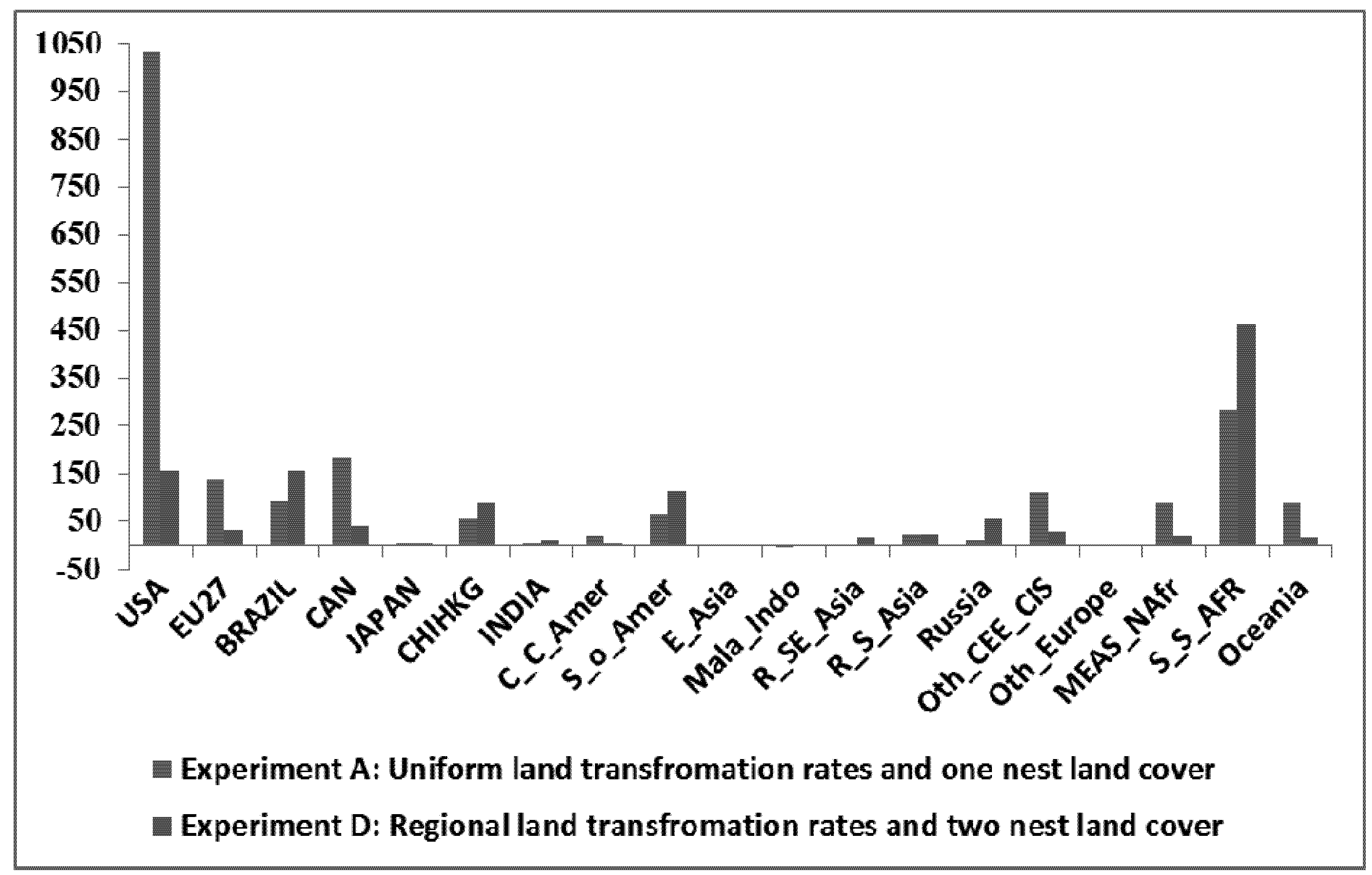
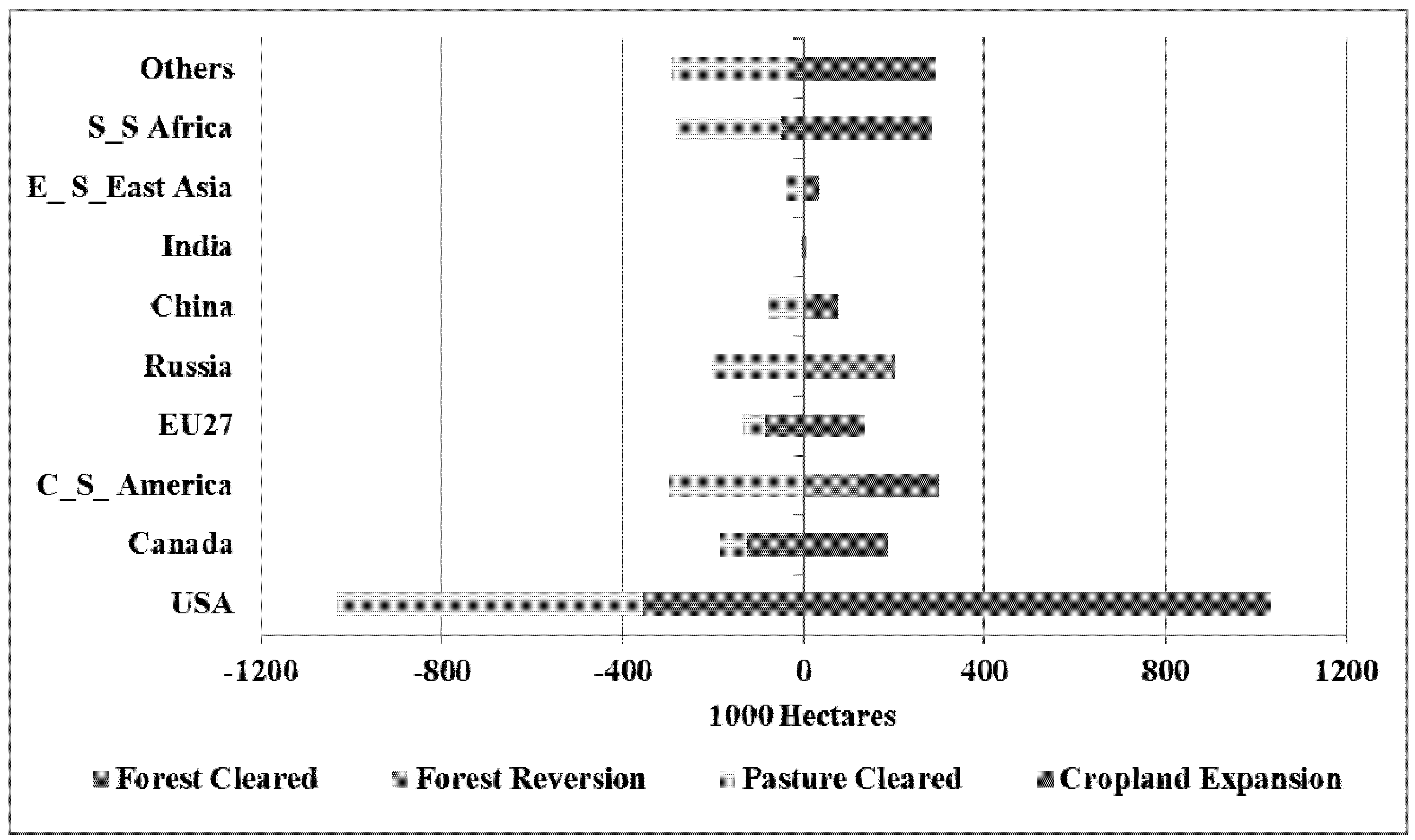
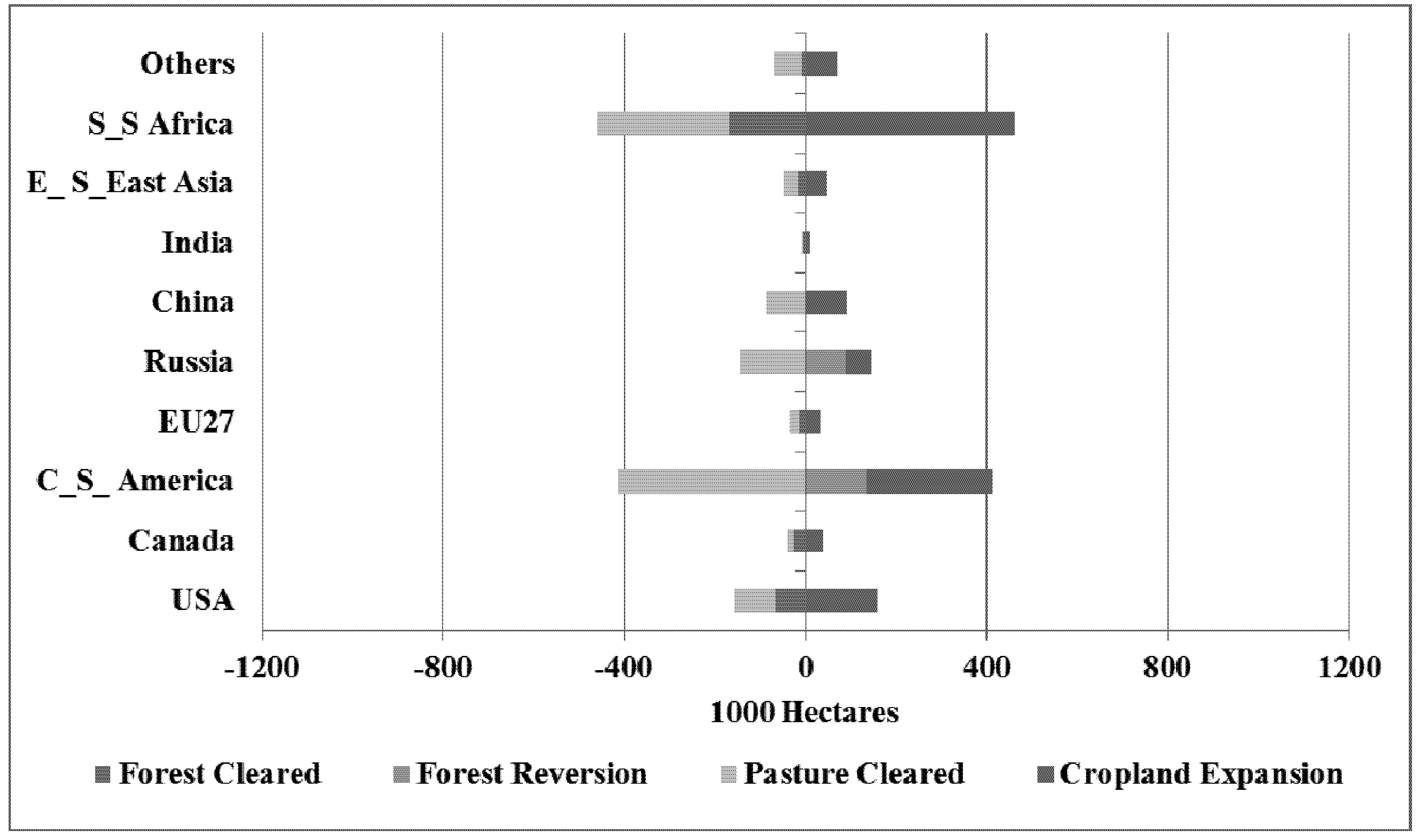
3.2. Land Use Emissions Due to Land Use Impacts of USA Ethanol Mandate
4. Conclusions
Acknowledgments
Appendix A
| Name of crop in FAO | MAP to 10 crops | Name of crop in FAO | MAP to 10 crops |
|---|---|---|---|
| Agave Fibres Nes | Fibers | Coconuts | Oil_Seeds |
| Alfalfa for forage and silage | Animal_Feed | Coffee, green | Others |
| Almonds, with shell | Ve_Fr_Food | Cow peas, dry | Ve_Fr_Food |
| Anise, badian, fennel, corian. | Animal_Feed | Cranberries | Ve_Fr_Food |
| Apples | Ve_Fr_Food | Cucumbers and gherkins | Ve_Fr_Food |
| Apricots | Ve_Fr_Food | Currants | Ve_Fr_Food |
| Arecanuts | Ve_Fr_Food | Dates | Ve_Fr_Food |
| Artichokes | Ve_Fr_Food | Eggplants (aubergines) | Ve_Fr_Food |
| Asparagus | Ve_Fr_Food | Fibre Crops Nes | Fibers |
| Avocados | Ve_Fr_Food | Figs | Ve_Fr_Food |
| Bambara beans | Ve_Fr_Food | Flax fibre and tow | Fibers |
| Bananas | Ve_Fr_Food | Fonio | CgrainNoCorn |
| Barley | CgrainNoCorn | forage Products | Animal_Feed |
| Beans, dry | Ve_Fr_Food | Fruit Fresh Nes | Ve_Fr_Food |
| Beans, green | Ve_Fr_Food | Fruit, tropical fresh nes | Ve_Fr_Food |
| Beets for Fodder | Animal_Feed | Garlic | Ve_Fr_Food |
| Berries Nes | Ve_Fr_Food | Ginger | Others |
| Blueberries | Ve_Fr_Food | Gooseberries | Ve_Fr_Food |
| Brazil nuts, with shell | Ve_Fr_Food | Grapefruit (inc. pomelos) | Ve_Fr_Food |
| Broad beans, horse beans, dry | Ve_Fr_Food | Grapes | Ve_Fr_Food |
| Buckwheat | CgrainNoCorn | Grasses Nes for forage;Sil | Animal_Feed |
| Cabbage for Fodder | Animal_Feed | Green Oilseeds for Silage | Animal_Feed |
| Cabbages and other brassicas | Ve_Fr_Food | Groundnuts, with shell | Oil_Seeds |
| Canary seed | CgrainNoCorn | Hazelnuts, with shell | Ve_Fr_Food |
| Carobs | Ve_Fr_Food | Hemp Tow Waste | Fibers |
| Carrots and turnips | Ve_Fr_Food | Hempseed | Oil_Seeds |
| Carrots for Fodder | Animal_Feed | Hops | Others |
| Cashew nuts, with shell | Ve_Fr_Food | Jojoba Seeds | Oil_Seeds |
| Cashewapple | Ve_Fr_Food | Jute | Fibers |
| Cassava | Ve_Fr_Food | Kapok Fruit | Fibers |
| Castor oil seed | Oil_Seeds | Karite Nuts (Sheanuts) | Oil_Seeds |
| Cauliflowers and broccoli | Ve_Fr_Food | Kiwi fruit | Ve_Fr_Food |
| Cereals, nes | CgrainNoCorn | Kolanuts | Ve_Fr_Food |
| Cherries | Ve_Fr_Food | Leeks, other alliaceous veg | Ve_Fr_Food |
| Chestnuts | Ve_Fr_Food | Leguminous for Silage | Animal_Feed |
| Chick peas | Ve_Fr_Food | Leguminous vegetables, nes | Animal_Feed |
| Chicory roots | Ve_Fr_Food | Lemons and limes | Ve_Fr_Food |
| Chillies and peppers, dry | Ve_Fr_Food | Lentils | Ve_Fr_Food |
| Chillies and peppers, green | Ve_Fr_Food | Lettuce and chicory | Ve_Fr_Food |
| Cinnamon (canella) | Others | Linseed | Oil_Seeds |
| Citrus fruit, nes | Ve_Fr_Food | Lupins | Animal_Feed |
| Clover for forage and silage | Animal_Feed | Maize | Grain_Maize |
| Cloves | Animal_Feed | Maize for forage and silage | Animal_Feed |
| Cocoa beans | Others | Maize, green | Ve_Fr_Food |
| Mangoes, mangosteens, guavas | Ve_Fr_Food | Ramie | Fibers |
| Manila Fibre (Abaca) | Fibers | Rapeseed | Oil_Seeds |
| Maté | Animal_Feed | Raspberries | Ve_Fr_Food |
| Melonseed | Oil_Seeds | Rice, paddy | Paddy_Rice |
| Millet | CgrainNoCorn | Roots and Tubers, nes | Others |
| Mixed grain | CgrainNoCorn | Rye | CgrainNoCorn |
| Mushrooms and truffles | Others | Rye grass for forage & silage | Animal_Feed |
| Mustard seed | Oil_Seeds | Safflower seed | Oil_Seeds |
| Natural rubber | Others | Seed cotton | Fibers |
| Nutmeg, mace and cardamoms | Others | Sesame seed | Oil_Seeds |
| Nuts, nes | Ve_Fr_Food | Sisal | Fibers |
| Oats | CgrainNoCorn | Sorghum | CgrainNoCorn |
| Oil palm fruit | Oil_Seeds | Sorghum for forage and silage | Animal_Feed |
| Oilseeds, Nes | Oil_Seeds | Sour cherries | Ve_Fr_Food |
| Okra | Ve_Fr_Food | Soybeans | Soybeans |
| Olives | Oil_Seeds | Spices, nes | Others |
| Onions (inc. shallots), green | Ve_Fr_Food | Spinach | Ve_Fr_Food |
| Onions, dry | Ve_Fr_Food | Stone fruit, nes | Ve_Fr_Food |
| Oranges | Ve_Fr_Food | Strawberries | Ve_Fr_Food |
| Other Bastfibres | Fibers | String beans | Ve_Fr_Food |
| Other melons (inc.cantaloupes) | Ve_Fr_Food | Sugar beet | Others |
| Papayas | Ve_Fr_Food | Sugar cane | Others |
| Peaches and nectarines | Ve_Fr_Food | Sugar crops, nes | Others |
| Pears | Ve_Fr_Food | Sunflower seed | Oil_Seeds |
| Peas, dry | Ve_Fr_Food | Swedes for Fodder | Animal_Feed |
| Peas, green | Ve_Fr_Food | Sweet potatoes | Ve_Fr_Food |
| Pepper (Piper spp.) | Others | Tallowtree Seeds | Oil_Seeds |
| Peppermint | Others | Tangerines, mandarins, clem. | Ve_Fr_Food |
| Persimmons | Ve_Fr_Food | Taro (cocoyam) | Ve_Fr_Food |
| Pigeon peas | Ve_Fr_Food | Tea | Others |
| Pineapples | Ve_Fr_Food | Tea Nes | Others |
| Pistachios | Ve_Fr_Food | Tobacco, unmanufactured | Others |
| Plantains | Ve_Fr_Food | Tomatoes | Ve_Fr_Food |
| Plums and sloes | Ve_Fr_Food | Triticale | CgrainNoCorn |
| Pome fruit, nes | Ve_Fr_Food | Tung Nuts | Oil_Seeds |
| Popcorn | CgrainNoCorn | Turnips for Fodder | Animal_Feed |
| Poppy seed | Oil_Seeds | Vanilla | Others |
| Potatoes | Ve_Fr_Food | Vegetables fresh nes | Ve_Fr_Food |
| Pulses, nes | Ve_Fr_Food | Vegetables Roots Fodder | Animal_Feed |
| Pumpkins for Fodder | Ve_Fr_Food | Vetches | Others |
| Pumpkins, squash and gourds | Ve_Fr_Food | Walnuts, with shell | Ve_Fr_Food |
| Pyrethrum, Dried | Animal_Feed | Watermelons | Ve_Fr_Food |
| Quinces | Ve_Fr_Food | Wheat | Wheat |
| Quinoa | CgrainNoCorn | Yams | Ve_Fr_Food |
| Yautia (cocoyam) | Ve_Fr_Food |
Appendix B
| Region | Description | Corresponding Countries in GTAP |
|---|---|---|
| USA | United States | Usa |
| EU27 | European Union 27 | aut, bel, bgr, cyp, cze, deu, dnk, esp, est, fin, fra, gbr, grc, hun, irl, ita, ltu, lux, lva, mlt, nld, pol, prt, rom, svk, svn, swe |
| BRAZIL | Brazil | Bra |
| CAN | Canada | Can |
| JAPAN | Japan | Jpn |
| CHIHKG | China and Hong Kong | chn, hkg |
| INDIA | India | Ind |
| C_C_Amer | Central and Caribbean Americas | mex, xna, xca, xfa, xcb |
| S_o_Amer | South and Other Americas | col, per, ven, xap, arg, chl, ury, xsm |
| E_Asia | East Asia | kor, twn, xea |
| Mala_Indo | Malaysia and Indonesia | ind, mys |
| R_SE_Asia | Rest of South East Asia | phl, sgp, tha, vnm, xse |
| R_S_Asia | Rest of South Asia | bgd, lka, xsa |
| Russia | Russia | Rus |
| Oth_CEE_CIS | Other East Europe and Rest of Former Soviet Union | xer, alb, hrv, xsu, tur |
| R_Europe | Rest of European Countries | che, xef |
| MEAS_NAfr | Middle Eastern and North Africa | xme, mar, tun, xnf |
| S_S_AFR | Sub Saharan Africa | bwa, zaf, xsc, mwi, moz, tza, zmb, zwe, xsd, mdg, uga, xss |
| Oceania | Oceania countries | aus, nzl, xoc |
Appendix C
A Test to Determine Sources of Expansion in Harvested Area of Maize and Oilseeds (MO)
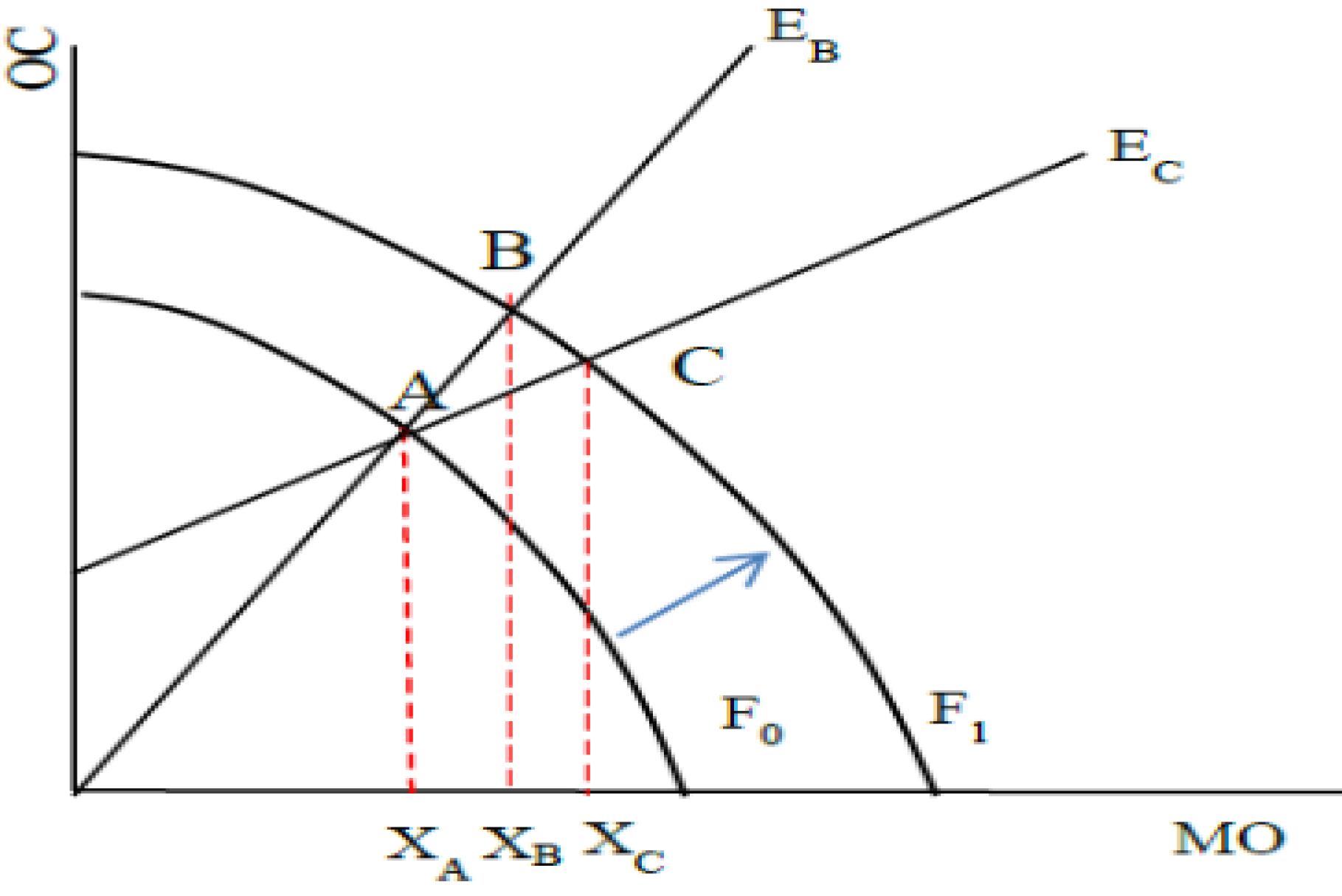
References
- Houghton, R.A. Revised estimates of the annual net flux of carbon to the atmosphere from changes in land use and land management: 1850–2000. Tellus B 2003, 55, 378–390. [Google Scholar] [CrossRef]
- Ramankutty, N.; Foley, J.A. Estimating historical changes in global land cover: Croplands from 1700 to 1992. Global Biogeochem. Cycles 1999, 13, 997–1027. [Google Scholar] [CrossRef]
- Global Forest Resource Assessment 2010; Food and Agricultural Organization of the United Nation: Rome, Italy, 2010.
- Tokgoz, S.; Elobeid, A.; Fabiosa, J.F.; Hayes, D.J.; Babcock, B.A.; Yu, T.; Dong, F.; Hart, C.E.; Beghin, J.C. Emerging Biofuels: Outlook of Effects on U.S. Grain, Oilseed, and Livestock Markets; Staff Report 07-SR 101; Center for Agricultural and Rural Development: Ames, IA, USA, 2007. [Google Scholar]
- Kammen, D.M.; Farrell, A.E.; Plevin, R.J.; Jones, A.D.; Delucchi, M.A.; Nemet, G.F. Energy and Greenhouse Impacts of Biofuels: A Framework for Analysis; Discussion paper 2007–2; Joint Transport Research Centre: Berkeley, CA, USA, 2007. [Google Scholar]
- Searchinger, T.; Heimlich, R.; Houghton, R.; Dong, F.; Elobeid, A.; Fabiosa, J.; Tokgoz, S.; Hayes, D.; Yu, T. Use of U.S. Croplands for Biofuels Increases Greenhouse Gases Through Emissions from Land-Use Change. Science 2008, 319, 1238–1240. [Google Scholar] [CrossRef]
- Hertel, T.; Golub, A.; Jones, J.; O’Hare, M.; Pelvin, R.; Kammen, D. Effects of USA Maize Ethanol on Global Land Use and Greenhouse Gas Emissions: Estimating Market-Mediated Responses. BioScience 2010, 60, 223–231. [Google Scholar] [CrossRef]
- Al-Riffai, P.; Dimaranan, B.; Laborde, D. Global Trade and Environmental Impact Study of the EU Biofuels Mandate; International Food Policy Research Institute: Washington, DC, USA, 2010. [Google Scholar]
- EPA, Renewable Fuel Standard Program (RFS2) Regulatory Impact Analysis; United States Environmental Protection Agency: Washington, DC, USA, 2010.
- Taheripour, F.; Hertel, T.; Tyner, W.; Bechman, J.; Birur, D. Biofuels and Their By-Products: Global Economic and Environmental Implications. Biomass Bioenergy 2010, 34, 278–289. [Google Scholar] [CrossRef]
- Tyner, W.; Taheripour, F.; Zhuang, Q.; Birur, D.; Baldos, U. Land Use Changes and Consequent CO2 Emissions due to USA Corn Ethanol Production: A Comprehensive Analysis; Department of Agricultural Economics: West Lafayette, IN, USA, 2010. [Google Scholar]
- Taheripour, F.; Hertel, T.; Tyner, W. Implications of Biofuels Mandates for the Global Livestock Industry: A Computable General Equilibrium Analysis. Agric. Econ. 2011, 42, 325–342. [Google Scholar] [CrossRef]
- Laborde, D. Assessing the Land Use Change Consequences of European Biofuels Policies; International Food Policy Research Institute: Washington, DC, USA, 2011. [Google Scholar]
- Wicke, B.; Verweij, R.; Meijl, H.; Vuuren, D.; Faaij, A. Indirect Land Use Changes: Review of Existing Models and Strategies for Mitigation. Biofuels 2012, 3, 87–100. [Google Scholar] [CrossRef]
- Ahmed, S.; Hertel, T.; Lubowski, R. Calibration of a Land Cover Supply Function Using Transition Probabilities; GTAP Research Memorandum No 12; Center for Global Trade Analysis: West Lafayette, Indiana, USA, 2008. [Google Scholar]
- Palatnik, R.; Kan, I.; Rapaport-Rom, M.; Ghermandi, A.; Eboli, F.; Shechter, M. Land Transformation Analysis and Application. Presented at the 14th Annual Conference on Global Economic Analysis. Venice, Italy, June 2011. [Google Scholar]
- Taheripour, F.; Tyner, W.; Wang, M. Global Land Use Changes due to the U.S. Cellulosic Biofuel Program Simulated with the GTAP Model; Purdue University, Department of Agricultural Economics: West Lafayette, IN, USA, 2011. [Google Scholar]
- Tyner, W.; Taheripour, F.; Golub, A. Calculation of Indirect Land Use Change (ILUC) Values for Low Carbon Fuel Standard (LCSF) Fuel Pathways; Interim report prepared for California Air Resource Board; Purdue University, Department of Agricultural Economics: West Lafayette, IN, USA, 2011. [Google Scholar]
- Lubowski, R. Determinants of Land Use Transitions in the United States: Econometrics Analysis of Changes among the Major Land-Use Categories. Ph.D. Thesis, Harvard University, Cambridge, MA, USA, February 2002. [Google Scholar]
- USDA, Grassland to Cropland Conversion in the Northern Plains: The Role of Crop Insurance, Commodity, and Disaster Programs; Economic Research Report Number 120; Economic Research Service: Washington, WA, USA, 2011.
- Gurgel, A.; Reilly, J.; Paltsev, S. Potential Land Use Implications of a Global Biofuels Industry. J. Agric. Food Ind. Organization 2007, 5. Article 9. [Google Scholar]
- Plevin, R.; Gibbs, H.; Duffy, J.; Yui, S.; Yeh, S. Agro-Ecological Zone Emission Factor Model; California Air Resource Board: Sacramento, CA, USA, 2011. [Google Scholar]
© 2013 by the authors; licensee MDPI, Basel, Switzerland. This article is an open-access article distributed under the terms and conditions of the Creative Commons Attribution license (http://creativecommons.org/licenses/by/3.0/).
Share and Cite
Taheripour, F.; Tyner, W.E. Biofuels and Land Use Change: Applying Recent Evidence to Model Estimates. Appl. Sci. 2013, 3, 14-38. https://doi.org/10.3390/app3010014
Taheripour F, Tyner WE. Biofuels and Land Use Change: Applying Recent Evidence to Model Estimates. Applied Sciences. 2013; 3(1):14-38. https://doi.org/10.3390/app3010014
Chicago/Turabian StyleTaheripour, Farzad, and Wallace E. Tyner. 2013. "Biofuels and Land Use Change: Applying Recent Evidence to Model Estimates" Applied Sciences 3, no. 1: 14-38. https://doi.org/10.3390/app3010014
APA StyleTaheripour, F., & Tyner, W. E. (2013). Biofuels and Land Use Change: Applying Recent Evidence to Model Estimates. Applied Sciences, 3(1), 14-38. https://doi.org/10.3390/app3010014




